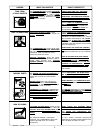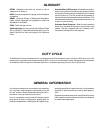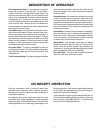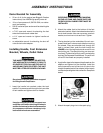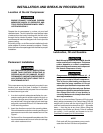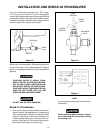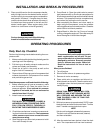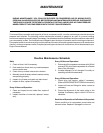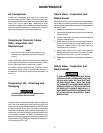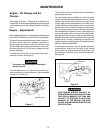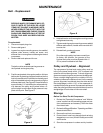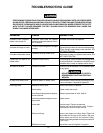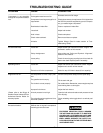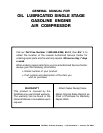
14
MAINTENANCE
Engine - Oil Change and Air
Cleaner
See Briggs & Stratton "Operating and Maintenance
Instructions" for information regarding engine oil changes
and air cleaner service as well as for warranty informa-
tion.
Turn the needle valve 1 1/2 revolutions counterclock-
wise to establish a point of reference. Start the engine
and allow it to warm up.
The air cleaner must be in place when any carburetor
adjustments are made.
Turn the needle valve clockwise (in) until the engine
misses, noting the valve position (lean mixture). Turn the
needle valve counterclockwise (out) until engine runs
roughly, again noting valve position (rich mixture). Now,
turn the needle valve clockwise (in) to the point midway
between lean and rich where the engine runs smoothly.
If the compressor stalls frequently during acceleration
from idle speed to full speed, richen mixture slightly (by
turning the needle valve out slowly). If this adjustment
does not eliminate the stalls, adjust the idle speed to a
slightly higher level by loosening the two jam nuts on the
throttle control cylinder, readjusting its position and
retightening the nuts. See Figure 6. Proper idle speed is
between 2400 and 2600 RPM.
If the throttle mechanism fails to operate smoothly,
preventing the engine from returning to full throttle
speed when tank pressure falls below 90 psig, it may
be necessary to lubricate it with a light lubricating oil.
See Figure 6.
Figure 5
Figure 6
HIGH ENGINE SPEEDS GREATLY IN-
CREASE VIBRATION LOADS ON AIR TANK.
THIS COULD WEAKEN THE TANK AND
CAUSE IT TO RUPTURE OR EXPLODE.
DAMAGE TO THE ENGINE CAN ALSO
OCCUR. ENGINE RPM MUST BE SET PER
SPECIFICATION.
Engine - Adjustments
Read the Briggs & Stratton "Operating and Maintenance
Instructions" that were provided with your compressor.
The gasoline engine was adjusted and set at the factory
to ensure correct operation. However, variations in
gasoline quality and octane, humidity, altitude or load
may adversely affect engine performance. As a result,
minor adjustments of fuel mixture or speed controls
may be necessary.
To adjust the fuel mixture, turn the needle valve clock-
wise until it closes. See Figure 5.
The needle valve point may be damaged if
turned in too far.



